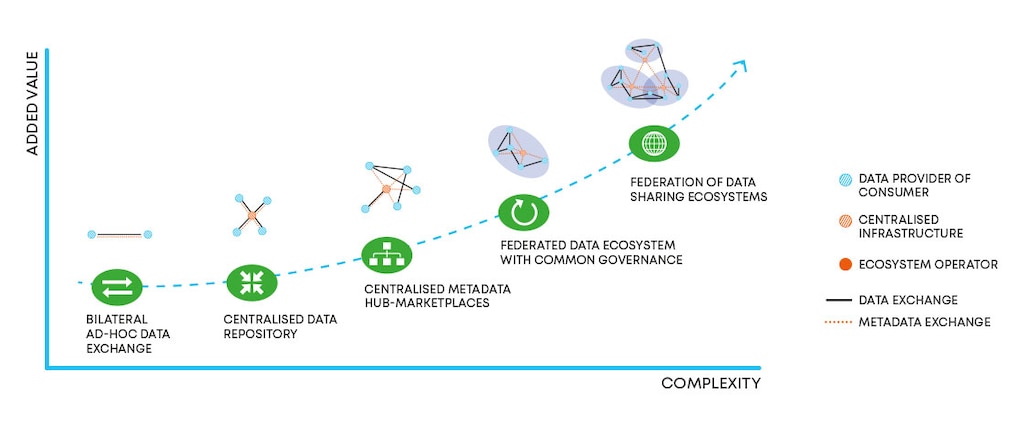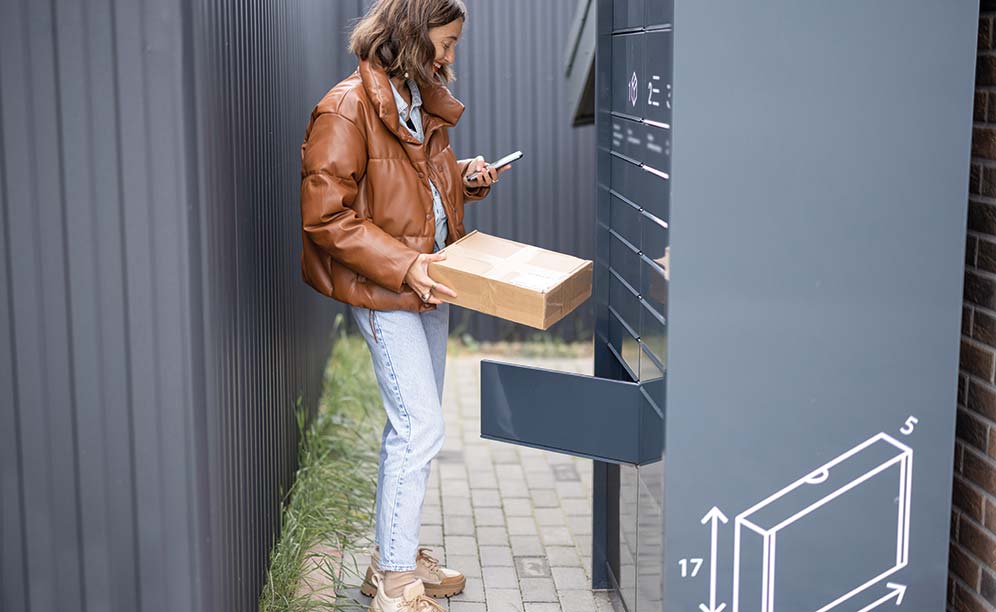
SARA SÁNCHEZ
Researcher, Zaragoza Logistics Center
Urban logistics plays a critical role in promoting sustainable and liveable cities. In designing sustainable urban logistics, it is crucial to consider both urban development trends and the application of innovations in urban distribution.¹ Urban logistics faces a twofold challenge due to the pressure to reduce its urban effects (i.e., congestion, noise and primarily greenhouse gas emissions) while simultaneously fostering innovation. The digitalisation of mobility is seen as the transition toward more efficient transport systems.²

In recent years, this digitalisation has been widely regarded as a solution for enhancing the capacity and efficiency of transport and energy systems by boosting decarbonisation initiatives.³ Digitalisation brings significant benefits to the supply chain, such as greater availability of information, optimisation of logistics practices, real-time data collection, more efficient inventory management and increased transparency.⁴
Digitalisation entails the use of diverse technologies and platforms to store, organise and manage large amounts of data. These platforms, known as data spaces, enable the availability of existing data while respecting usage control and privacy for data owners.
Data spaces: a strategic asset
A data space is an ecosystem where various actors share data voluntarily and securely, following common governance, organisational, regulatory and technical mechanisms. These measures guarantee the trust and sovereignty of participants over their data, generating an ecosystem of peer-to-peer data sharing. In a data space, each participant maintains control over their own data, indicating the terms and conditions under which they can be used.
In the framework of the European Strategy for Sustainable and Smart Mobility, data is a key strategic asset. The European Union backs up mobility data spaces to positively impact the mobility sector, advancing towards a more efficient, safe and sustainable transport system.
Data spaces in urban logistics
In the context of urban logistics, a data space refers to a digital environment where relevant data are managed and stored for logistics operations in urban areas. The integration of digital technologies improves their efficiency, visibility and management. Several European projects have addressed the use of data spaces in the field of urban logistics.

One such project is DISCO, an acronym for Data-driven, Integrated, Synchromodal, Collaborative and Optimised urban freight meta-model for a new generation of urban logistics and planning with data sharing at European Living Labs. DISCO aims to fast-track upscaling to a new generation of urban logistics and smart planning, enable the transition to decarbonised and digital cities, deliver innovative frameworks and tools and change the urban logistics and planning paradigm with a Physical Internet (PI) approach.
The resulting dynamic and optimal space reallocation integrates urban freight within an efficiently operated network-of-networks (PI-led). This process leverages underused lands and assets and includes both fixed and mobile infrastructure, adapting to throughput demands. This is achieved through four game changers:
- Empowering end-to-end visibility across the supply chain.
- Co-creating an innovative enabling city ‘cloud’ ecosystem for trust and data protection.
- Driving cities in effectively delivering new urban logistics sustainable planning.
- Fast-tracking adoption and replication of innovative business models based on participatory, data-driven and sharing principles.
Laying down DISCO
To facilitate the implementation of DISCO measures, the urban freight data spaces complement the Meta Model Suite by introducing semantic interoperability into data management systems on multiple levels. These systems handle commercial, proprietary and open data, fostering coordinated data sharing and value creation at any DISCO-X level.
The five DISCO-X models building the Meta Model Suite are:
- DISCOCURB. Mixed-use and dynamic street space management. It involves the smart and flexible use of kerbsides (e.g., loading or on-street parking zones) through the application of advanced data analytics and digital twins.
- DISCOPROXI. Based on using urban corners or lockers for nearby deliveries and omnichannel shipments. The aim is to optimise multiple pick-up and delivery solutions at localised, mixed-used lands and micro hubs with low-emission vehicles, e.g., cargo bikes.
- DISCOESTATE. This consists of retrofitting building space for multi-tenant and temporary use to enhance the reliability of B2B/B2C deliveries.
- DISCOBAY. Multimodal bays are focused on mutualised and multimodal (e.g., rail/waterborne) distribution centres for green last-mile-pooling delivery to improve the carbon footprint.
- DISCOLLECTION. Smart data collection methods are employed for advanced access control and real-time routing.
DISCO works horizontally and in collaboration with cities, which discuss and compare common problems to learn from each other. Several examples of cities applying data spaces to urban logistics include Copenhagen (Denmark), Ghent (Belgium), Thessaloniki (Greece) and Helsinki (Finland).
Copenhagen: logistics service providers’ data
The city of Copenhagen uses shared transport facilities as urban micro hubs and open consolidation hubs through real-time data collection from logistics service providers. City officials are working on an innovative dynamic space management and urban planning tool to serve as a small-scale use case for effective flexible kerbside utilisation. They are also developing a new sustainable business model for an open consolidation hub in the city, utilising shared transport facilities for goods through smart solutions. This initiative aims to attract more couriers to the existing urban micro hubs.
Ghent: Dynamic Access Control
In the case of Ghent, innovation lies in public-private cooperation for dynamic data-driven and automated communications. This effort seeks to incentivise effective and zero-emission operations in last-mile deliveries. Stakeholders are working on upgrading and integrating the Dynamic Access Control (DAC). This system streamlines communication for sustainable delivery options and re-routing of freight vehicles. It achieves this by generating suitable drop-off options in specific city hubs and implementing optimal and sustainable routes and delivery methods. The goal is to promote the use of cargo bikes and urban waterway barging.
Thessaloniki: logistics centres in underused facilities
Thessaloniki is proposing a logistics hub concept involving the multi-purpose, multi-tenant and temporary use of buildings. This approach is supported by optimally positioned road sensors for smart data collection, helping to detect freight flows and facilitating zero-emission freight transport. Officials are developing innovative business models and services for free space use by adopting smart contracts. The city community aims to enhance its WareM&O (warehouse as a service) platform solution with blockchain. The platform already integrates a fair pricing algorithm designed to facilitate WaaS business agreements.
Additionally, stakeholders are working on the optimal temporary and multi-purpose use of strategically positioned buildings at the TIF HELEXPO Exhibition Centre. This initiative seeks to transform the facility into a logistics hub when events are not taking place. The objective is to operate with shared transport and logistics facilities (e.g., freight hotels) and optimise them through smart methods and tools as well as green last-mile solutions.
Helsinki: zero-emission zones
The Finnish capital is creating multifunctional micro hubs with network management and flexible use of space promoting the use of zero-emission freight transport modes (bikes and vans). Officials are implementing a fast-track dynamic kerbside management system enabling flexible use of dedicated loading/unloading zones and parking areas/spots. This includes the introduction of a mobile micro hub concept, zone monitoring and the simulation of a dynamic low-emission zone.
The city is also developing a new business model allowing companies to efficiently set up operations in a network of multifunctional micro hubs. These micro hubs will be set up in underused urban spaces, bringing benefits to residents and local economies as well. Examples of these advantages include shared e-scooters, e-bikes with adjoining charging stations, maintenance and storage services for bikes and pick-up lockers. The outcomes of the demo in Helsinki are expected to decrease pollution from last-mile logistics and increase service levels in the city.

Other cities committed to a green last mile
In Spain, Barcelona, Valencia and Zaragoza are boosting advanced B2C/B2B last-mile delivery for local commerce. They are leveraging micro hubs in underused spaces, powered by smart predictive models and zero-emission vehicles.
- Barcelona. The city is developing an innovative kerb operations management process for parking slots in chamfered loading/unloading areas based on available space. It assigns parking slots to incoming vehicle requests within a specific time window, accommodating various vehicle sizes. Moreover, Barcelona is applying dynamic freight modelling techniques and advanced data analytics solutions to enhance the efficiency and effectiveness of logistics operations. This involves optimising freight flows using smart sensors installed at loading/unloading parking spots for real-time data collection.
- Valencia. Stakeholders are working on demonstrating micro hubs in underutilised spaces, providing services for both B2B and B2C companies. These micro hubs operate with unified fleets of 100% electric and zero-emission vehicles. Furthermore, Valencia is identifying and repurposing untapped areas and available public-owned land to create an extended map of potentially available space as consolidation centres.
- Zaragoza. Project participants are establishing a new collaboration model between a last-mile service provider and the City Council. The aim is to pinpoint a currently underused urban space and install a logistics micro hub equipped with electric charging points to support last-mile operations. In addition, stakeholders are actively involved in implementing data-driven logistics services to support local initiatives and sustainable freight transport. This entails integrating digital innovations with an intensive use of freight data.
All three cities are promoting advanced business models for novel urban logistics patterns, leveraging spaces within the city and in peri-urban areas to provide reliable last-mile B2C/B2B solutions. The models enable mapping of underutilised micro hubs for efficient just-in-time management, fostering increased connections with local businesses, social innovation and citizen involvement. This showcases how underexploited and empty public and private spaces can function as consolidation centres, facilitating contact and negotiations between owners of spaces and operators and creating new business models.
Data spaces pave the way for connected logistics, where all stakeholders can exchange data securely and reliably. The DISCO project illustrates this, charting a new course for future logistics projects to build upon.
Dr. Sara Sánchez is a Research Fellow at the MIT-Zaragoza International Logistics Programme (Spain). She has dedicated part of her professional career to the Aragon Institute for Engineering Research (I3A) as an engineering researcher in sustainable mobility. With broad experience in international transport and logistics companies, she has spearheaded strategic projects across various European countries and overseen logistics implementations at both national and international levels.
References
- He, Zhangyuan, and Hans-Dietrich Haasis. 2020. A Theoretical Research Framework of Future Sustainable Urban Freight Transport for Smart Cities. Sustainability 12 (5): 1975.
- Noussan, Michel, Manfred Hafner, and Simone Tagliapietra. 2020. The Future of Transport between Digitalization and Decarbonization. SpringerBriefs in Energy. Cham: Springer International Publishing.
- Canzler, Weert, and Andreas Knie. 2016. Mobility in the Age of Digital Modernity: Why the Private Car Is Losing Its Significance, Intermodal Transport Is Winning and Why Digitalisation Is the Key. Applied Mobilities 1 (1): 56–67.
- Bigliardi, Barbara, Serena Filippelli, Alberto Petroni, and Leonardo Tagliente. 2022. The Digitalisation of Supply Chain: A Review. Procedia Computer Science 200: 1806–15.
- Laborda, Josep, Eglantina Dani, Luke Bates, Jim Ahtes, and Rizkallah Touma. Unlocking the Future of Mobility with European Data Spaces. EIT Urban Mobility, Factual Consulting, I2CAT Foundation. 7 November, 2023.
- DISCO - Upscaling a New Generation of Urban Logistics. n.d. DISCO.
